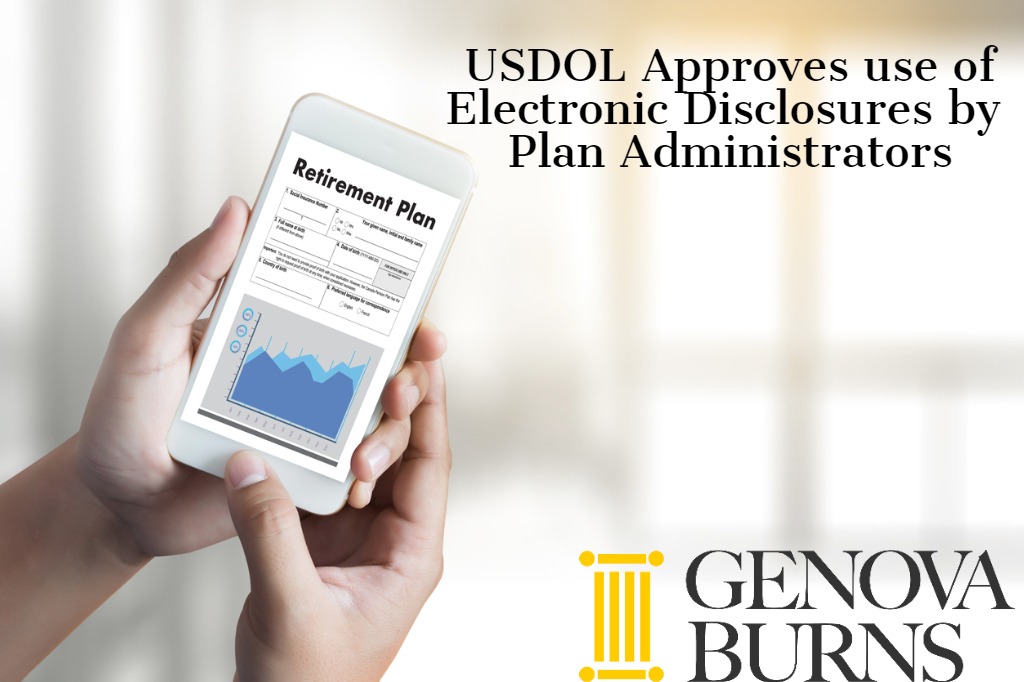USDOL Approves Use of Electronic Disclosures by Retirement Plan Administrators
June 18, 2020 | By: Patrick W. McGovern, Esq., Gina M. Schneider, Esq.
On May 21, 2020 the U.S. Department of Labor (“DOL”) issued a new rule creating a voluntary safe harbor for retirement plan administrators who prefer to provide ERISA-mandated retirement plan information and disclosures to participants and beneficiaries electronically, as the default method (“Electronic Disclosure Rule”). The DOL estimates that over the next decade ERISA retirement plans that take advantage of the Electronic Disclosure Rule will save several billion dollars in costs by eliminating paper mailings of mandated disclosures and notices. The Electronic Disclosure Rule comes at a key time for retirement plan sponsors and employers as they are confronted by novel regulatory issues and the increased costs of business and plan compliance associated with the COVID-19 pandemic.
Background
The Electronic Disclosure Rule, originally proposed in late 2019, is the DOL’s response to a 2018 Presidential Executive Order addressing the use of electronic delivery to improve the effectiveness of required plan disclosures and notices and reduce associated costs and burdens on plan administrators. Since 2002, retirement plans have been permitted to use electronic disclosure for certain mandated disclosures, but not as a default method, and not without having to jump over costly and burdensome administrative hoops (“2002 Rule”). The Electronic Disclosure Rule supplements the 2002 Rule.
Summary of Key Provisions
The Electronic Disclosure Rule allows retirement plan administrators to use either of the two optional methods for electronic delivery and thereby satisfy their statutory duty under ERISA to provide plan documents to covered individuals.
- Website Posting. Plan administrators may post covered documents on a website if appropriate notification of internet availability is furnished to the email addresses of covered individuals each time a new covered document is posted or via a single annual notice, including among other things, a link to the website that provides access to the documents. Documents must be posted until a subsequent version of the document is posted, but in no event less than one year.
- Email Delivery. Plan administrators may send covered documents directly to the email addresses of covered individuals, with the covered documents either in the body of the email or as an attachment to the email.
The Electronic Disclosure Rule applies only to disclosure of covered documents (any pension plan-related document or information required to be provided under Title I of ERISA, other than one provided only upon request) to covered individuals (persons entitled under ERISA to receive covered documents and who have a valid electronic address (e.g., email address or smart phone number).
Before transitioning to electronic disclosure, plan administrators must first advise covered individuals via paper of the change in the plan’s current method of retirement plan disclosures (e.g., paper delivery in the U.S. mail), the new electronic delivery method, the email address that will be used, and the rights to opt out of electronic disclosures or make specific requests for paper copies of certain documents, at no cost to them and at any time.
The Electronic Disclosure Rule also requires the plan administrator to monitor whether a covered individual’s email address is invalid or inoperable and, when an employee terminates employment, take steps to ensure the continued accuracy and operability of the email address on file.
Effective Date and Additional Guidance on Non-Retirement Plan Disclosures
The Electronic Disclosure Rule is effective July 26, 2020 (60 days after its publication in the Federal Register), however the Department, as part of its broader effort to provide flexibility and reduce administrative burdens during the COVID-19 pandemic, will take no enforcement action against plan administrators who immediately rely on this Rule.
As of now the Electronic Disclosure Rule is limited to retirement plans and does not apply to health and welfare plans.
For more information about the Electronic Disclosure Rule or general compliance with retirement or other employee benefit plans, please contact Patrick W. McGovern, via email or Gina M. Schneider, via email, in the Firm’s Employee Benefits Practice Group.
Tags: GENOVA BURNS LLC • Patrick McGovern • Gina M. Schneider • ERISA • DOL Final Rule



